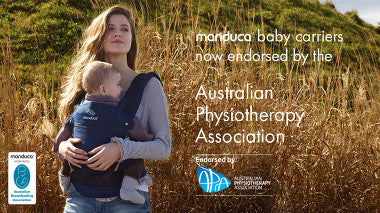
Well, we know all of the hidden and amazing qualities of the Manduca organic baby carrier but it's nice to announce that it's just become the only baby carrier officially endorsed by the Australian Physiotherapy Association (APA).
The APA is Australia’s peak professional body representing the interests of Australian physiotherapists and their patients.
Christine Kininmonth of Fertile Mind, the Australian distributor, met up with Australian Physiotherapy Association (APA) Corporate Services’ General Manager Craig Maltman plus head of marketing Maree Whittingham to celebrate the announcement.
Craig told Christine the APA endorsed the manduca organic baby carrier as it exhibited features aligned with the values of the physiotherapy profession and the APA.
It's an exhaustive process as the APA assesses products before endorsing them, so the APA’s endorsement of the manduca baby carrier acknowledges it as a product providing quality, value and security.
Fertile Mind recently ran a survey about baby carriers and slings (the Babywearing in Australia survey), and found that more than 80% of surveyed parents believed health providers should be the ones providing information about optimal and safe babywearing.
So, Christine says, the endorsement will help to bring an optimal carrier such as manduca to the attention of health professionals and their patients.”
As manduca fans know, and feel, manduca carries baby in the correct “spread-squat M position” which may prevent hip dysplasia.
It can be worn in conjunction with equipment recommended by orthopaedic health professionals to correct infant hip issues.
Actually, the Hip Dysplasia Org website makes for fascinating reading, not least of all because the "froggy" or "M" position of the baby's legs in a spread/squat position is also referred to as the "human position"!
Teaching parents to holdi their babies in a "human" position is kind of funny when you think about it, but obviously necessary when you read more on the site.
To summarise the findings: An unborn baby spends a long time tucked in the fetal position, in which both hips and knees are bent or flexed and after birth, it takes several months for the joints to stretch out naturally.
The hip joint is a ball and socket joint. During the first few months of life the ball is more likely to be loose within the socket because babies are naturally flexible and because the edges of the socket are made of soft cartilage like the cartilage in the ear.
Christine points out that 18 years ago she was taught by her hospital midwives to strictly swaddle her baby like an Egyptian mummy, but the Hip Dysplasia Org site suggests that if the hips are forced into a stretched-out position too early, the ball is at risk of permanently deforming the edges of the cup shaped socket (hip dysplasia) or gradually slipping out of the socket altogether (hip dislocation).
Hip dysplasia or dislocation in babies is not painful so this may go undetected until walking age and may also result in painful arthritis during adulthood.
The risk of hip dysplasia or dislocation is greatest in the first few months of life.
By six months of age, most babies have nearly doubled in size, the hips are more developed and the ligaments are stronger, so are less susceptible to developing hip dysplasia.
So, while the International Hip Dysplasia Institute makes a point of saying it cannot endorse nor advise against any particular baby carrier, it can recommend that parents choose a carrier that offers the correct froggy, spread/squat or human position.
Happily, as well as optimal positioning for hips, Manduca's adjustability suits parents and carers of all sizes, and features highly tuned weight distribution that renders a heavy baby almost weightless on the wearer.
Comfort, after all, is the reason we all enjoy wearing the manduca and benefitting from the health outcomes proven to result from babywearing.
